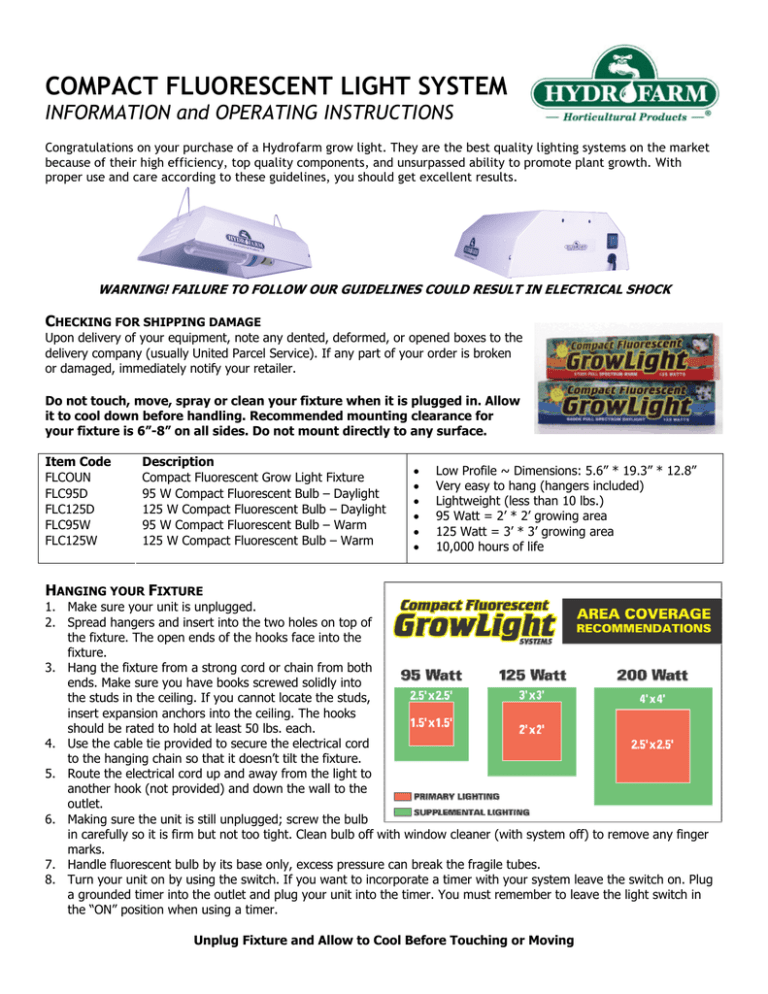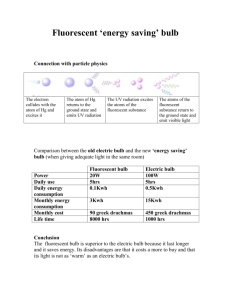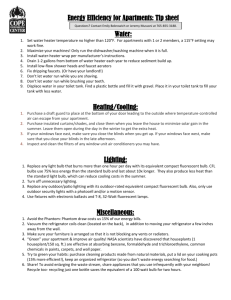compact fluorescent light system
advertisement

COMPACT FLUORESCENT LIGHT SYSTEM INFORMATION and OPERATING INSTRUCTIONS Congratulations on your purchase of a Hydrofarm grow light. They are the best quality lighting systems on the market because of their high efficiency, top quality components, and unsurpassed ability to promote plant growth. With proper use and care according to these guidelines, you should get excellent results. WARNING! FAILURE TO FOLLOW OUR GUIDELINES COULD RESULT IN ELECTRICAL SHOCK CHECKING FOR SHIPPING DAMAGE Upon delivery of your equipment, note any dented, deformed, or opened boxes to the delivery company (usually United Parcel Service). If any part of your order is broken or damaged, immediately notify your retailer. Do not touch, move, spray or clean your fixture when it is plugged in. Allow it to cool down before handling. Recommended mounting clearance for your fixture is 6”-8” on all sides. Do not mount directly to any surface. Item Code FLCOUN FLC95D FLC125D FLC95W FLC125W Description Compact Fluorescent Grow Light Fixture 95 W Compact Fluorescent Bulb – Daylight 125 W Compact Fluorescent Bulb – Daylight 95 W Compact Fluorescent Bulb – Warm 125 W Compact Fluorescent Bulb – Warm • • • • • • Low Profile ~ Dimensions: 5.6” * 19.3” * 12.8” Very easy to hang (hangers included) Lightweight (less than 10 lbs.) 95 Watt = 2’ * 2’ growing area 125 Watt = 3’ * 3’ growing area 10,000 hours of life HANGING YOUR FIXTURE 1. Make sure your unit is unplugged. 2. Spread hangers and insert into the two holes on top of the fixture. The open ends of the hooks face into the fixture. 3. Hang the fixture from a strong cord or chain from both ends. Make sure you have books screwed solidly into the studs in the ceiling. If you cannot locate the studs, insert expansion anchors into the ceiling. The hooks should be rated to hold at least 50 lbs. each. 4. Use the cable tie provided to secure the electrical cord to the hanging chain so that it doesn’t tilt the fixture. 5. Route the electrical cord up and away from the light to another hook (not provided) and down the wall to the outlet. 6. Making sure the unit is still unplugged; screw the bulb in carefully so it is firm but not too tight. Clean bulb off with window cleaner (with system off) to remove any finger marks. 7. Handle fluorescent bulb by its base only, excess pressure can break the fragile tubes. 8. Turn your unit on by using the switch. If you want to incorporate a timer with your system leave the switch on. Plug a grounded timer into the outlet and plug your unit into the timer. You must remember to leave the light switch in the “ON” position when using a timer. Unplug Fixture and Allow to Cool Before Touching or Moving ELECTRICAL USAGE To figure how much amperage your unit is using, simply use the following formula: Wattage ÷ Voltage = Amperage. The average household circuit breaker is rated at 20 amps. If the total amperage drawn from that circuit approaches 20 amps, the circuit breaker will trip off. You probably have one or two circuits per room. If you have a 1000-watt unit running off a 120-volt circuit, it will draw approximately 9 amps. For the cost of electricity to run your grow light, we recommend that you check with your local power company, since the cost will vary depending on the geographical area. A 1000-watt light will probably cost 10 per hour to operate. Make sure your household circuits or fuses are in good condition and are rated at least 33% over what the load will be (e.g. no more than a 15-amp load on a 20-amp circuit). Drawing too much current can overheat the wiring due to low voltage or insufficient amperage in that household circuit. Extension cords should not be used with the systems. BULB REPLACEMENT Fluorescent bulbs should be replaced after approximately 1-1½ years of continuous use (18 hour days). At these points, light output and electrical efficiency have decreased so that replacement is recommended. Do not run bulbs continuously beyond their rated lives. Always unplug your system and allow bulb to cool before changing the light bulb. HOURS OF LIGHT There is a mechanism in plants which tracks time. This response is called photoperiodism. Plants respond to the length of light and darkness that they receive. Different plants may respond in different ways, such as rosette growth of lettuce versus bolting, bulb formation of onions versus leaf and stem formation, flowering of chrysanthemum, and so forth. The right mix of light and dark causes flower, fruit and seed production. The following is a list of plants and their response to light. These are general guidelines and may not be exact. Recommended Minimum Footcandles PLANT (Approximate) PHOTOPERIOD Azalea 1,000 Short Day Chrysanthemums 2,000 Short Day Coffee 1,000 Day Neutral Cucumbers 4,000 Day Neutral Coleus 1,000 Long Day Cineraria 1,000 Long Day Gloxinia 1,000 Long Day Saint Paulia, Sainpaulia 1,000 Long Day Geranium 1,500 Short Day Pepper (Sweet) Everbearing 2,000 Day Neutral Strawberries 2,000 Day Neutral Sweet Pea 2,000 Day Neutral Tomatoes 2,000 Day Neutral Plants are classified in regard to photoperiodism as long day plants, short day, and day neutral plants. It is actually the length of darkness that initiates the response by the plant. Many texts will relate photoperiod as short night and long night plants. To avoid confusion we will use length of day as the criteria. Long day plants are those that require a minimal dark period in order to flower. Plants that normally flower in late spring or summer are generally considered to be long day plants. Long day plants generally require at least 16 hours of light to trigger flowering. Plants in this category remain vegetative when days are short. The general recommendation for lighting of long day plants is to increase lights from approximately 12-14 up to 16-18 hours per day over the normal life cycle of the plant. Short day plants usually require at least 12 hours of darkness to flower. Plants that normally flower in the short days of autumn or winter are generally known as short day plants. Plants on this schedule usually require 16-18 hours of light for the vegetative cycle and approximately 12 hours of light to initiate bloom cycle. Day neutral plants do not respond to the length of light or dark periods. Most vegetables are day neutral. These plants may respond to other factors such as temperature or days to maturity. Generally plants in this category can be grown with 12-16 hours of light. Plants with precise photoperiod requirements have what is referred to as a photocritical point. Disrupting the dark cycle with light, by turning on a lamp or allowing street light through a window, can cause plants to remain in the vegetative stage. Exact photoperiod has not been established for all plants. Consult your local nursery or garden book if you are unsure of the photoperiod response for the plants you wish to grow. SOME PRECAUTIONS ¾ ¾ ¾ ¾ ¾ ¾ ¾ ¾ ¾ ¾ ¾ ¾ ¾ Do not touch your fixture when it is plugged in. Always unplug from the outlet and allow to cool when moving or replacing parts on your light. Never pull the cord to unplug the system. Pull the plug only. Do not run a bulb beyond recommended replacement schedule – see Bulb Replacement. Do not look directly into the bulb during startup or operation. Avoid scratching your bulb, subjecting it to undue pressure, or getting it wet when it is hot, as any of these could cause it to break. In the event of bulb breakage, shut off power immediately to prevent exposure to ultraviolet energy, which may be harmful to eyes and skin. Protect the bulb from moisture. Always make sure there is adequate air circulation (use a fan) in your growing area. Keep the room temperature below 95°F. If your growing area is extremely warm or if you need to increase air circulation, fan options are available for your light. Check with your Hydrofarm dealer for more information. Your plants should be far enough away from the bulb to prevent heat damage. If the leaves wilt or show other signs of burn damage, the light is too close. Usually about 1 to 3 feet is right for a fluorescent light. Less distance is allowable for light loving plants. Use caution when moving your plants from lower light situations (windows or fluorescents) to a high intensity Halide or Sodium. They can get sunburned. Keep the light an extra foot away and increase the number of hours of exposure over a couple of days. Always use a heavy-duty three-prong grounded timer, rated for at least 15 amps. TROUBLESHOOTING If your fixture does not work, try the following step-by-step procedures 1. Check your electrical source. Make sure the unit is plugged in properly and that the breaker is not tripped or the fuse blown. 2. Check your grounded timer – plug the unit directly into your outlet. 3. Unplug the unit and make sure the lamp is screwed in all the way. 4. If you have another working identical unit, unplug it and interchange bulbs to identify the faulty part. THE HYDROFARM GUARANTEE We guarantee our compact fluorescent fixtures to be free of defects, mechanical or physical, for one year, unless otherwise specified. Misuse, abuse, or failure to follow instructions is not covered. If you have a problem, check the troubleshooting guide and electrical connection to isolate the problem. If this does not remedy the situation or your system was damaged during shipping, call the place of purchase. Save your receipt or invoice as it will be required for all warranty work.


